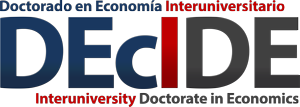- Referencia: Martínez-Carrión, J.M., Román-Cervantes, C. y Candela-Martínez, B.: “Entre los más altos de España. El estado nutricional en las Canarias occidentales: cohortes masculinas de 1860-1915”. 2018, Nutrición Hospitalaria, 35, Extra (5), 39-46.
Abstract Objetivo: analizamos la dinámica del estado nutricional en las Canarias con datos de la altura masculina durante la segunda mitad del siglo xix y su dimensión en el contexto español.Métodos: con datos del reclutamiento militar, hacemos una estimación de la talla promedio masculina en edades de 19-21 años por cohortes de nacimiento para el…
- Referencia: Ramon-Muñoz, R., Ramon-Muñoz, J.M. y Candela-Martínez, B.: “Sibhsip size, height and cohort selection: a methodological approach”. 2021, International Journal of Environmental Research and Public Health, 182, 3369.
Abstract This article deals with the historical relationship between the number of siblings in a family or household and height, a proxy for biological living standards. Ideally, this relationship is better assessed when we have evidence on the exact number of siblings in a family from its constitution onwards. However, this generally requires applying family…
- Referencia: Candela-Martínez, B., Ramallo-Ros, S., Cañabate, J. y Martínez-Carrión. J.M.: “Month of birth and height. A case study in rural Spain”. 2022, Economics and Human Biology (in press).
Abstract Introduction.- Season of birth correlates to a wide range of health conditions throughout life measured by anthropometrics. This study explores whether the month of birth and weather during gestation influence male adult height, based on Spain’s rural population before the end of the modernization process. Methods.- The database of heights (N = 16.266) is composed of…
- Referencia: y Candela-Martínez, B.: “Growing taller unequally? Adult height and socioeconomic status in Spain (Cohorts 1940–1994)”. 2022, SSM - Population Health (in press).
Abstract Socioeconomic inequalities and their evolution in different historical contexts have been widely studied. However, some of their dimensions remain relatively unexplored, such as the role played by socioeconomic status in the trajectory of biological living standards, especially net nutritional status. The main objective of this article is to analyze whether the power of socioeconomic…
- Referencia: y Candela-Martínez, B.: “Biological Well-Being and Inequality in Canary Islands: Lanzarote (Cohorts 1886–1982)”. 2021, International Journal of Environmental Research and Public Health, 18: 12843.
Abstract Developments in anthropometric history in the Iberian Peninsula have been remarkable in recent decades. In contrast, we barely know about the behavior of insular population groups and infants’ and adults’ growth during the nutritional transition in the Canary Islands. This paper analyzes the height, weight and body mass index of military recruits (conscripts) in…
- Referencia: Ladeuix, Joaquín y Pablo Schiaffino: “Riche comme un argentin: desigualdad educativa en la Argentina de la belle époque”. 2020, Investigaciones de Historia Económica - Economic History Research, 16(2020): 57-75.
En el presente trabajo demostramos que la Argentina de la belle époque fue, de forma persistente, un país regionalmente desigual en términos de capital humano. Aunque la distribución de los maestros y de las tasas de enrolamiento mejoran significativamente entre 1883 y 1914, la distribución de las tasas de alfabetización no mejora a la par….
- Referencia: Martínez-Soto, A. P y Susana Martínez-Rodríguez: “Graneries (pósitos): a source of finance for Spain´s small farmers, 1900-1950.»”. 2025, Continuity and Change. v. 30, n. 2, 251-277.
Abstract: Under the Ancien Régime in Spain local granaries (in Spanish, pósitos) acted as welfare institutions designed to help small farmers in times of crisis. During the first third of the twentieth century they were subject to an intense reorganisation in Spain and this transformed them into the only microfinance institution to which a significant part of the…
- Referencia: Guinnane, T y Susana Martínez-Rodríguez: “Flexibility in the Spanish Company Law, 1885-1936”. 2025, Revista de Historia Industrial, v. 56, 81-113.DOI:
ABSTRACT The Spanish business code allowed firms two types of organizational flexibility in the late 19th and early 20th century. Firms enjoyed great leeway in adapting rules to their needs. The corporation was especially flexible in this way. Spanish law also allowed firms to in effect crea- te their own legal form. Until 1920, firms…

